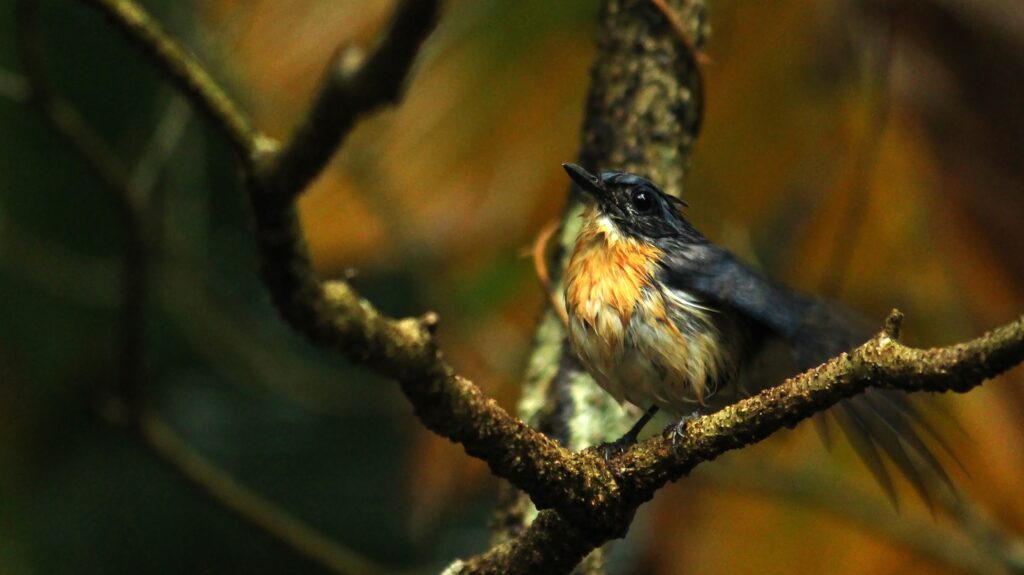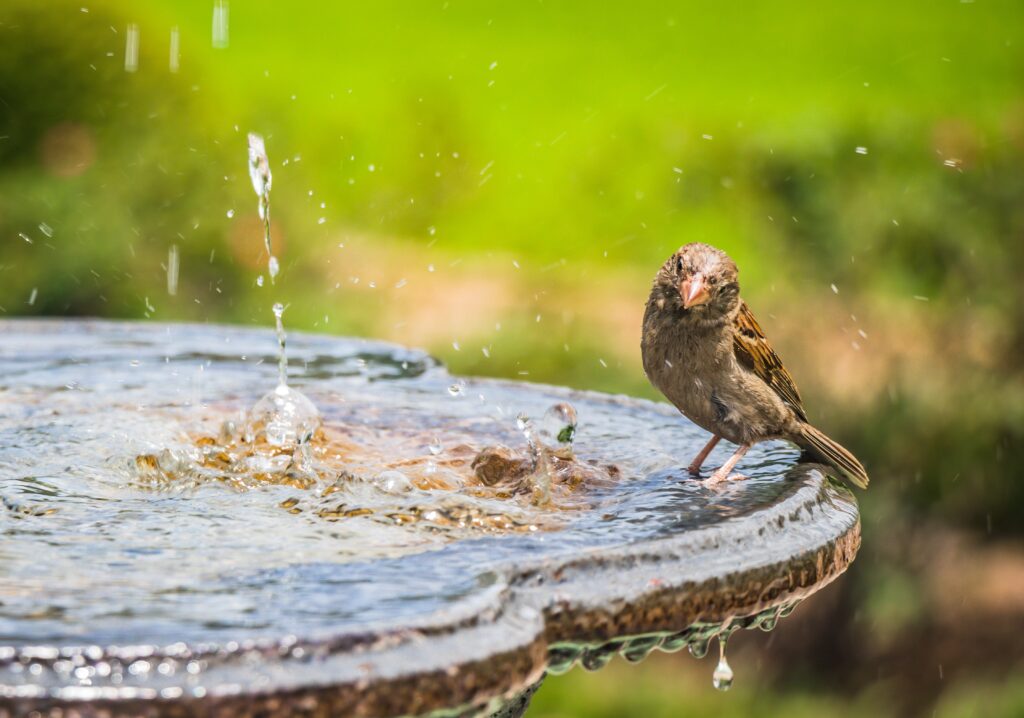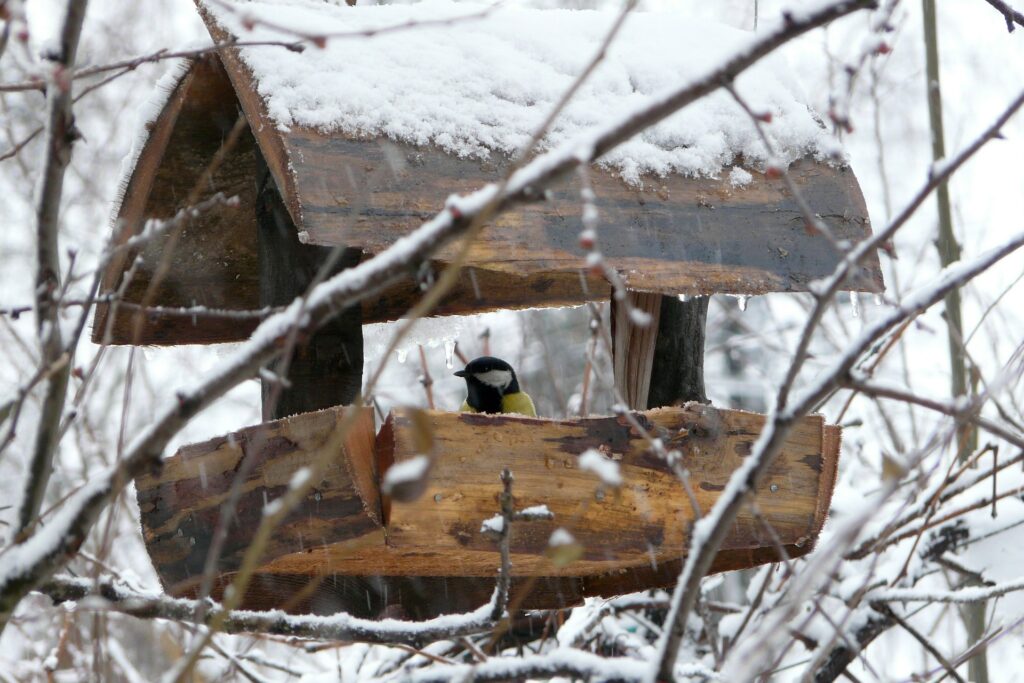Have you ever looked out the window during a snow flurry and wondered how birds are braving the cold? Or on hot summer days, when the temperature tops one hundred degrees, do you think about how birds stay cool? Just like us humans, birds are having to deal with extreme weather conditions more frequently as a result of climate change. Here’s how the weather affects birds, and what we can do to help them survive, and thrive, in any climate.
Birds in Rain and Wind

It’s not just your imagination that you see fewer birds during a rainstorm; birds typically don’t like flying when it’s wet. It’s not the light rain that causes them to hunker down (they usually resume their normal activities in mild precipitation). It’s hard rain and wind that makes them seek shelter in trees, hedges, and other places. On top of that, the air temperature that comes with rain is typically lower, making it harder for birds to fly.
Why do birds seek shelter in rain? It’s not because they can’t fly; in fact, birds use oil from their preen gland (near their tail) to coat their feathers, making them waterproof. Birds seek shelter for other reasons. First, the cold temperature that often accompanies rain can cause hypothermia, causing birds to seek a warm place to shelter. Second, flying takes a lot of energy, and birds typically rest to conserve their energy in colder temperatures. Some birds, like shorebirds, also huddle in groups for heat, and mother birds use their feathers to cover their babies for warmth.
But not all birds have a hard time in the rain—waterfowl, as you would imagine, love it! That’s why you’ll often find ducks and other water birds flying, hunting for insects, and all-around having a good time when it’s wet.
Watch this mother and father shrike protect their chicks from the rain:
Birds in Snow and Freezing Temperatures

Did you know that a bird’s feet and legs prevent them from losing heat, even when standing on snow or ice? The cold blood in a bird’s feet, and their counter-current circulation, retains heat, and their feathers trap air and hold warmth. Their natural protection against the cold notwithstanding, birds still need to shelter in snow and freezing conditions. Just like in the rain, birds will hunker down in the hollow of a tree, a thick shrub, or a bird house. And, if it gets cold enough, they’ll fly miles away in search of a warmer place.
Harsh winters pose another threat to birds: a lack of natural food sources. Insects, berries, and other bird fare are harder to find as temperatures drop, causing many birds to leave their habitat for warmer weather. It’s also the reason you may find a lot more birds at your feeders in the colder months (and why it’s so important to offer high-quality bird seed mixes and high-energy food like suet in the winter).
Birds in the Heat

Just like us, birds need help staying cool in the baking sun. But unlike us, birds can’t sweat, so they must find other ways to regulate their body temperature in extreme heat. Some birds, like the Great Horned Owl, breathe through a membrane in their neck (called gular fluttering). Other birds, particularly passerines, pant much like dogs to cool off. But while these behaviors are limited to a few bird species, most birds deal with the heat by looking for shelter and water, and by saving most of their activity for the later, cooler part of the day.
Watch this Great Horned Owl keep cool with a behavior called “gular fluttering”:
How to Help Birds in any Weather
As climate change continues to affect all of us, extreme weather has become part of our reality. Unfortunately, the bird population has already seen a drastic decline, and these changes only make matters worse. Between loss of habitats and food sources, natural disasters and extreme weather conditions make it hard for birds to survive in this ever-changing ecosystem. What can we do to help?

- Provide shelter. Bird houses, roosting boxes, nest boxes: all are excellent places for birds to beat the heat and cold.
- Feed the birds. Hang a bird feeder or two (or more!) for year-round bird feeding, but especially in winter, when birds need the extra energy to survive the cold, raise their young, and get ready for long migrations.
- Offer water year-round. Not just in the parching heat, but in all weather. Add a birdbath to your garden, yard, or deck. There are even heated options that keep the water from freezing, so birds can still drink and bathe as temperatures drop. You can also create movement (and attract more birds) by adding a bubbler to your birdbath.
What’s New for Chirp in 2022?
We have so many fun things in store for you this year! Keep an eye on our Activities page for upcoming fun, family-friendly, bird-loving events—we’re adding them all the time!


